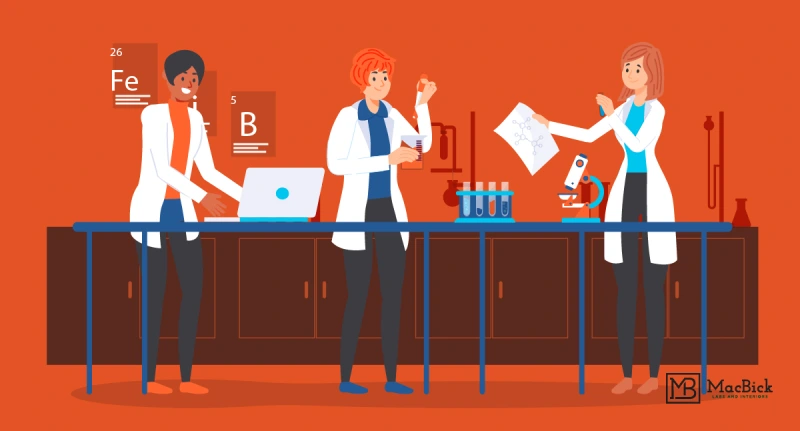If you run a laboratory, you know the daily challenges—especially when it comes to storage. Labs handle hazardous chemicals, sensitive biological samples, and fragile equipment. Without optimized storage, the risks of accidents, contamination, and unnecessary exposure multiply.
According to the U.S. Occupational Safety and Health Administration (OSHA), over 500,000 laboratory workers are exposed to hazardous chemicals every year. Proper storage is one of the simplest yet most effective ways to reduce these risks.
But safety isn’t the only concern—productivity suffers too. How much time can you afford to waste searching for a missing sample or reagent? The answer should be “zero seconds.” Yet in many labs, inefficient storage leads to lost time, misplaced inventory, and slower research outcomes.
That’s why experts emphasize the need for storage solutions that support smooth and efficient lab operations. Researchers and scientists prefer laboratories that are not only well-equipped but also thoughtfully designed for durability, ergonomics, and space management.
A well-organized lab doesn’t just look professional—it directly impacts safety, workflow, and scientific discovery. Let’s explore the different types of laboratory storage systems and how they can transform your workspace.
3 Things You Must Know for the Best Storage Solution for Your Laboratory
Every minute counts in a lab. Wasted time searching for samples or handling clutter can slow research and compromise results. Proper storage solutions not only reduce these frustrations but also improve safety and reliability. Here are three essentials to look for before you invest:
Sample Duration Every material has its own metabolic activity, which defines the duration of its storage to prevent decay. Based on the sample’s duration, you can choose the best storage solution for your lab.
Workflow How heavy is the workload? How much manpower is needed? How quick is the connectivity between equipment and researchers? Answers to these questions vary by lab—and so do the solutions.
Space Every piece of equipment has its space requirements. Researchers also need appropriate space to work efficiently. Storage is evolving with technology, IoT, and automation to make labs safer and more efficient. Explore this post to learn more about the future of smart labs.
Top Storage Solutions for Your Lab in 2024
1. Cryogenic Storage: Super-Cold Ambiance for Samples There is always high demand for cold storage when preserving samples for extended periods. Cryogenic storage makes it easier to store and transport cryogenic liquids, super-cold fuels, natural gases, and more.
Why Wasn’t Traditional Cooling Sufficient? Standard cooling can slow chemical decay but cannot stop it completely. Cryogenic storage maintains ultra-low temperatures (as low as -132°C), halting biochemical activity and preventing further degradation.
Methods Based on Material Type
- Cryobanks: Used to store super-cold fuels and gases in cryogenic tanks
- Cryogenic Dewars: Insulated vacuum flasks for transporting and storing cryogenic liquids
- Cryogenic Energy Storage (CES): Stores energy in solid (e.g., rock), liquid (e.g., liquid nitrogen), or gas (e.g., air) form
2. Modular Casework: An Efficient Way to Store Modular casework offers ergonomic storage through advanced cabinet systems that support easy lab installation, quick equipment movement, and simple retrofitting.
What Does It Include? Lab casework kits are ready-to-use furniture sets for laboratories. These kits include lower cabinets and upper wall-mounted cabinets. You can customize them with hinged or sliding doors, solid or glass panels, or open shelving. Some kits also include sinks and backsplashes.
Fixed Millwork vs. Modular Casework Modular casework is more affordable and flexible than fixed millwork. It reduces installation labor and adapts easily to expanding or reconfigurable spaces. It’s one of the best options for labs that expect to grow or adjust in the future.
3. Pathology Storage: A Necessity for Security Pathogens are microbes that can cause infection or disease and are therefore considered infectious agents. Pathological waste, which often contains body fluids, requires high-precaution storage.
Precautions in Pathology Storage
- Airtight, nonporous containers with strong plastic coverings to prevent leaks
- Antimicrobial walls, floors, and ceilings in storage rooms
- Adjustable-height workbenches for flexible equipment arrangement
- Vertical storage carousels with automated software to rotate specimens and save over 70% of floor space compared to traditional methods
4. Fume Hoods: The Safety Essential Fume hoods are crucial in labs where workers are at risk of inhaling hazardous fumes, vapors, or dust. These ventilation systems protect workers from unsafe inhalation.
Fume hoods incorporate safe work surfaces made from nonporous, highly durable, and chemical-resistant materials like epoxy resin or phenolic resin. Experts strongly recommend fume hoods to protect the health of lab personnel.
5. IoT-Enabled Smart Solutions Technology is transforming lab storage. IoT-based solutions extend traditional methods by digitizing inventory functions.
These systems use software with sensors like RFID tags and readers to track items and manage inventory. They solve common lab issues such as poor connectivity between machines and researchers.
Reach out to MacBick Labs and Interiors or check out our portfolio if you’re looking for a smart storage solution for your lab. We’re here to help you find the best fit.



